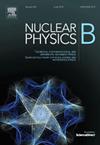IF 2.5
3区 物理与天体物理
Q2 PHYSICS, PARTICLES & FIELDS
引用次数: 0
摘要
自由中子的寿命是一个长期存在的难题:在束流实验中,自由中子的寿命大大超过了陷阱实验的相应结果。这种差异远远超出了实验误差范围。陷阱实验的结果是基于对中子的计数,而束流实验的结果则是基于对中子衰变为自由质子和自由电子(加上反中微子)的三体衰变所产生的质子的计数。众所周知,自由中子两体衰变为氢原子(加反中微子)的概率相对较小。为了解释上述谜题,与通常的三体衰变相比,这种二体衰变的分支比(BR)应该是 ∼ 1 %。然而,这种二体衰变的理论分支比(BR)先前已知要小几个数量级:4 × 10-6.我们在 2024 年的一篇论文(以下简称论文 I)中指出,在考虑到氢原子的狄拉克方程第二解之后,自由中子的两体衰变(转化为氢原子和反中微子)的理论衰变率提高了 ∼ 3000 倍,达到 ∼ 1 %。这样,中子寿命之谜似乎彻底解开了。在本文中,以这种方式解决中子寿命之谜只是通向 "基石"(即中心思想)的 "垫脚石":通向拟议的实验概念设计,这些实验将构成对自由中子两体衰变的首次实验探测,以及对自由中子两体衰变产生狄拉克方程第二解所描述的绝大多数氢原子的实验证实。本文章由计算机程序翻译,如有差异,请以英文原文为准。
Resolution of the neutron lifetime puzzle and the conceptual design of its experimental confirmation
The lifetime of free neutrons was a long-standing puzzle: in the beam experiments it significantly exceeded the corresponding result from the trap experiments. The difference far exceeded the experimental error margins. While the results of the trap experiments were based on counting neutrons, the results of the beam experiments were based on counting protons stemming from the three-body decay of a neutron into a free proton and a free electron (plus antineutrino). It was well-known that there is a relatively small probability for the two-body decay of a free neutron into a hydrogen atom (plus antineutrino). For explaining the above puzzle, the Branching Ratio (BR) for this two-body decay – compared to the usual three-body decay – should have been ∼ 1 %. However, the theoretical BR for such two-body decay was previously known to be smaller by several orders of magnitude: 4 × 10–6. In one of our papers of 2024 (hereafter paper I) it was pointed out that after taking into account the second solution of the Dirac equation for hydrogen atoms, the theoretical BR for the two-body decay of free neutrons (into hydrogen atoms and antineutrinos) got enhanced by a factor ∼ 3000 to become ∼ 1 %. Thus, the neutron lifetime puzzle appeared solved completely. In the present paper, the resolution of the neutron lifetime puzzle in this way is just the “stepping stone” leading to the “keystone” (i.e., to the central idea): to the proposed conceptual design of the experiments that will constitute both the first experimental detection of the two-body decay of free neutrons and the experimental confirmation that the two-body decay of free neutrons produces overwhelmingly the hydrogen atoms described by the second solution of the Dirac equation.
求助全文
通过发布文献求助,成功后即可免费获取论文全文。
去求助
来源期刊

Nuclear Physics B
物理-物理:粒子与场物理
CiteScore
5.50
自引率
7.10%
发文量
302
审稿时长
1 months
期刊介绍:
Nuclear Physics B focuses on the domain of high energy physics, quantum field theory, statistical systems, and mathematical physics, and includes four main sections: high energy physics - phenomenology, high energy physics - theory, high energy physics - experiment, and quantum field theory, statistical systems, and mathematical physics. The emphasis is on original research papers (Frontiers Articles or Full Length Articles), but Review Articles are also welcome.
 求助内容:
求助内容: 应助结果提醒方式:
应助结果提醒方式:


